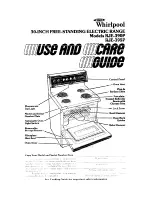
- 9 -
E
N
G
L
IS
H
1.3 Observe the formation of flue gas (atmospheric
inversion) and draughts when the weather is
unfavourable.
Infeed of too little combustion air can lead to smoke in
the rooms or to flue gas leaks. Hazardous deposits in
the stove and chimney may also occur.
If flue gas escapes, let the fire burn out and check
whether all the air inlet openings are free and the flue
gas pipes and the stove pipe are clean. If in doubt
notify the master chimney sweep since draught
malfunctions may be connected to your chimney.
1.4 Push the embers together to form a firebed when you
add new fuel.
1.5 Only use suitable tools when handling embers and
make sure that no embers fall out of the combustion
chamber onto inflammable material.
1.6 Use the equipment supplied to open the doors of your
stove, e.g. heat-resistant gloves.
1.7
Stoves type 1 (BA 1):
These may only be operated with the combustion
chamber door closed.
1.8
The combustion chamber door may only be
opened to add fuel and must then be closed again
otherwise other firing installations connected to the
chimney may be endangered. The combustion
chamber door is to be kept closed when the stove
is not in operation.
1.9
Fouling of the chimney i.e. deposits of highly
inflammable materials such as soot and tar and
subsequently fire in the chimney may occur if wet
fuel is used and operation is damped too much.
If this occurs phone the fire brigade and get yourself and
other residents out of harm’s way.
Note: The size of the combustion chamber door makes
it necessary, particularly with post-heating when
ablaze, not to open the door too abruptly to prevent
the tips of the flames reaching out.
Important information relating to ambient air
dependent and ambient air independent operation:
(Effective for Germany. Dated September 2002)
The Vitra woodburning stove
is tested in accordance with EN 13240 as an ambient air
dependent stove. This stove extracts its entire combustion
air requirements from the room in which it is installed via
the central air intake duct at the rear of the stove.
Thanks to the airtight configuration of the air supply line
and flue pipes the Vitra FC41x (for the LAS system) and
FC51x models comply with the approval principles for the
inspection and evaluation of ambient air independent
fireplaces specified by the Deutsches Institut für
Bautechnik (DIBT) (German Institute for Building
Technology) and the draft standard "Requirements for
testing ambient air independence, Part 1: Room heaters"
of the FNH standards committee (dated February 2004).
An application has been filed for the general technical
approval from the DIBT as an ambient air independent
stove.
When combined with ventilation and air conditioning
systems (e.g. controlled ventilation and aeration systems,
fume hoods, etc.) section 4 of the Firing Ordinance
(FeuVO) is applicable in Germany. An airtight (i.e. ambient
air independent) connection/operating mode (see point 2)
is to be ensured here or the stove is to be operated in an
ambient air dependent manner and secured to the
ventilation and air conditioning system or a ventilation
system which is approved for solid fuel firing systems and
is able to supply the installation area with the required
level of combustion air (approx. 20 m3/h) is to be installed.
Please ensure you comply with the applicable local rules
and regulations in consultation with your district master
chimney sweep. We do assume any liability for
modifications made after the publication of this information.
We reserve the right to make alterations.
Summary of Contents for Vitra Passivehouse
Page 1: ...1 Instruction Manual Vitra Passivehouse Instruction Manual...
Page 2: ...2...
Page 3: ...3 D I M E N S I O N S...
Page 4: ...4 S P A R E P A R T O V E R V I E W...
Page 19: ...19...






































